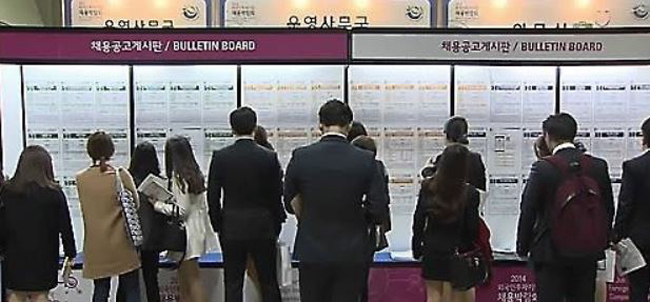South Korea's unemployment rate has risen steadily in the past few years, while jobless numbers among Organization for Economic Cooperation and Development members as a whole have fallen, official data showed Sunday.
Data by Statistics Korea and the OECD showed that Asia's fourth-largest economy has entered a recovery stage, albeit a weak one, but growth has not led to more positions being created. This is in contrast to most other OECD member states that reported improvements in the job market from 2013 through 2015.
In 2013, South Korea's national jobless rate stood at 3.1 percent, with numbers rising to 3.5 percent in the following year and hitting 3.6 percent in 2015, and edging up to 3.7 percent last year.
 |
(Yonhap) |
Besides South Korea, only Austria and Turkey experienced rises in annual unemployment during this period. Austria numbers hit 6 percent last year from 5.4 percent in 2013, while Turkey's stood at 10.9 percent in 2016 vis-a-vis 8.7 percent four years earlier.
During the same period the jobless rate for the OECD fell from 7.9 percent in 2013 to 7.4 percent in 2014, with numbers dipping to 6.8 in the following year and 6.3 percent in 2016.
Among leading countries, the unemployment rate for the United States stood at 4.9 percent last year from 7.4 percent in 2013, with Germany, Britain, France and Japan all showing improvement in their respective job markets.
The jobless rate for Japan stood at 3.1 percent in 2016, which is lower than South Korea in the same year.
An analysis of data, moreover, showed that South Korea's jobless rate is not showing signs of improvement in 2017.
The latest findings showed that by quarter, the unemployment rate among OECD members averaged 6.2 percent in the last three months of 2016, with this decreasing to 6 percent in the January-March period of this year and 5.8 percent in the second quarter.
The corresponding numbers for South Korea were 3.6 percent for the fourth quarter of last year and 3.8 percent in both the first and second quarters of 2017.
In addition, because roughly 20 percent of South Korea's workforce is self-employed, if they are forced to close their shops, they are not immediately counted as unemployed but rather as part of the economically inactive population, which can distort jobless rate figures.
By comparison, over 90 percent of US workers are salaried employees, with many experts claiming that in such cases a jobless rate of 5 percent should be seen as a state of full employment.
Reflecting the dilemma facing the country, local policymakers point out that while the jobless rate has been on the rise, among OECD members South Korea enjoys relatively low unemployment problems, along with Japan and Iceland.
Despite this assessment, the government is aware that the sluggish pace of industrial innovation and labor market reforms are adversely affecting the job market.
"There have been a host of factors that have posed problems in the creation of more work that includes weak growth and exports in the past few years," a finance ministry official said.
Sung Tae-yoon, an economics professor at Yonsei University, said a slowdown in growth in the past few years and labor market rigidity seems to be restricting new job creation.
Related to recent development, many economists said that more time is needed to see what effects the incumbent Moon Jae-in government's "jobs first" policy will have on unemployment numbers going forward.
After taking office in May, the new chief executive has focused his energy on job creation and even got parliament to pass an extra budget to create more public sector jobs.
A presidential panel on job creation is moreover expected to unveil a blueprint to address sluggish employment conditions in October. The plan is expected to provide a better picture of the strategy to be employed by this administration to get more people to work.
"At present the government will push forward job creation projects authorized by the extra budget passed earlier in the year and make certain the money is spent in a timely manner," an official source said. "Afterwards, more policy measures will be announced that can lead to more jobs." (Yonhap)








